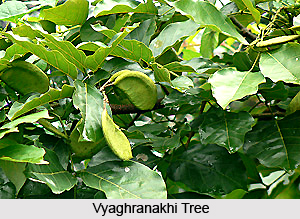 Vyaghranakhi is a popular Indian medicinal plant, having the botanical name of Ipomoea pes-tigridis L. Vyaghranakhi is the Sanskrit name of the plant and the English names of the plant are Bindweed, Cupid`s Flower and Tiger`s Foot. It has many names in several native Indian languages, as well. In Bengali, the plant is named as Langulilata and the Malayalam speaking people call it as Pulichuvatu. The plant`s names in Tamil are Pulichovadi or Punaikkirai, while in Telugu, it is known as Chikunuvvu, Meka-Madugu and Puritikada.
Vyaghranakhi is a popular Indian medicinal plant, having the botanical name of Ipomoea pes-tigridis L. Vyaghranakhi is the Sanskrit name of the plant and the English names of the plant are Bindweed, Cupid`s Flower and Tiger`s Foot. It has many names in several native Indian languages, as well. In Bengali, the plant is named as Langulilata and the Malayalam speaking people call it as Pulichuvatu. The plant`s names in Tamil are Pulichovadi or Punaikkirai, while in Telugu, it is known as Chikunuvvu, Meka-Madugu and Puritikada.
The spreading or climbing annual vascular plant, Vyaghranakhi is clothed with long, spreading yellow hairs. The leaves of the plant have a length of up to 11 cm and width of 13 cm, and though sometimes entire, they are usually palmately 5-9-lobed. The lobes are narrowly oval to egg-shaped, and they are narrowed above and below. The length of the lobes is 1.6-7 cm and the width is 1-2.8 cm and they are thinly pubescent to strigose on both surfaces. The outer bracts are ovate or elliptic-oblong, while the inner bracts are narrow-acute. The flowering part of the plant that is the few-flowered bracteate heads is placed on pubescent peduncles and they are up to 14 cm long. The bracts of the plant are foliaceous, oblong to oblong-lanceolate and pubescent outside. While the outer bracts are up to 5 cm long and 0.6 cm wide, the inner ones are narrower and shorter.
The flowers of Vyaghranakhi plant are sub-sessile and the sepals are lanceolate and pubescent, having a length of 0.8-1.2 cm. The corolla of the plant has a colour of white, pink or purple, and the funnel-shaped corolla is 3.5-5 cm long. The plant`s fruits are capsular, ovoid, papery, brown and glabrous, having a length of 0.8-0.9 cm and a diameter of about 0.5 cm. There are usually 4 black seeds that have a length of 0.4 cm and their colour is grey-pubescent. The plant generally flowers from the month of July to November and fruits from November to December.
Vyaghranakhi plant is commonly found throughout India to an elevation of about 1200 m in dry, open habitats like agricultural fields, grasslands and in coastal areas. The plant can mostly be found as a climber on bushes and hedges. It has several medicinal properties and usages. Vyaghranakhi plant is used in the treatment of boils and carbuncles and also as an antidote to dog bites. The Indian people apply the leaves of the plant as a poultice for getting relief from boils, pimples and sores. Apart from that, the root of the plant is used as a purgative, as well.



















